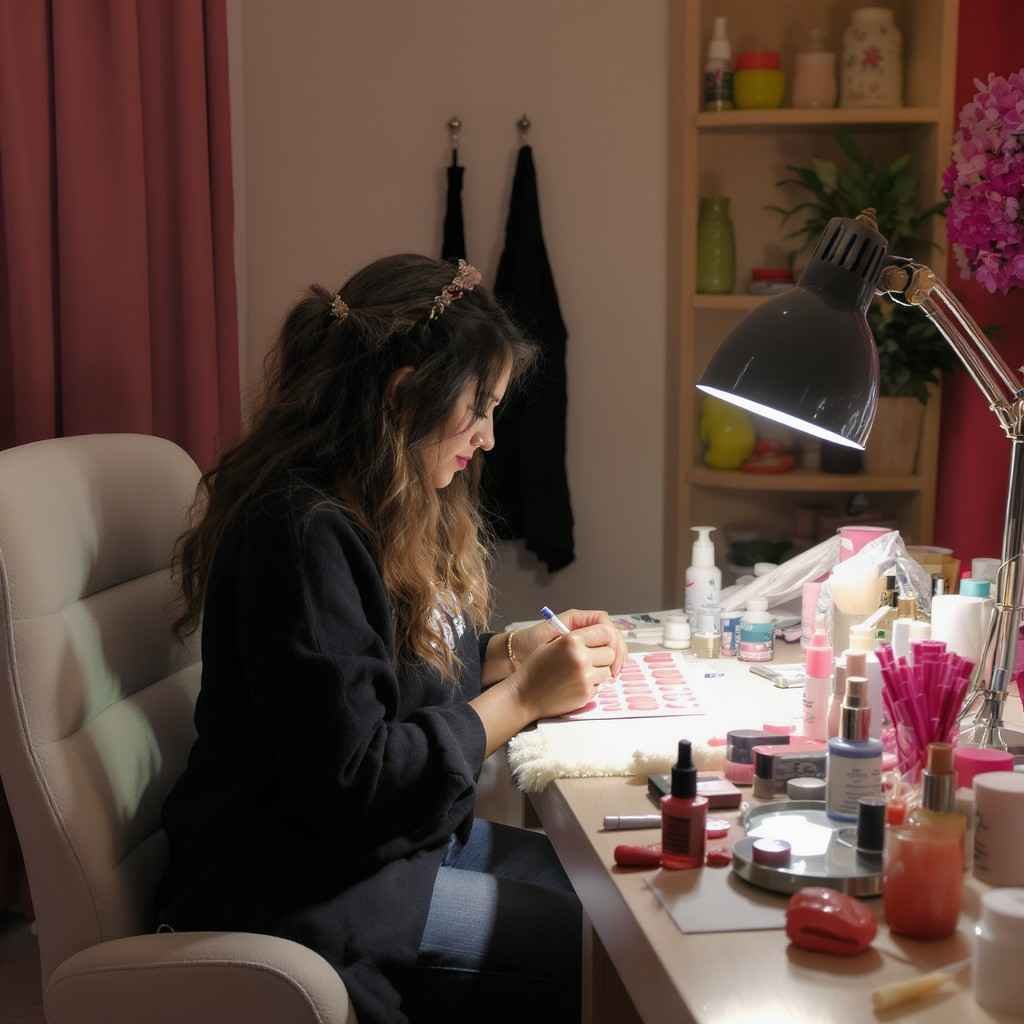Curing gel polish isn’t just a step in the nail process; it’s the foundation for a flawless, long-lasting manicure. Over the years, I’ve experimented with everything from beginner kits to professional curing lamps. If there’s one truth I’ve learned, it’s that proper curing determines the success or failure of your gel manicure. In this comprehensive guide, I’ll walk you through everything you need to know, including prep, products, technique, tools, and aftercare. Whether you’re a seasoned nail tech or a DIY enthusiast, this article will arm you with actionable techniques backed by real experience, science, and precision.
Key Takeaways:
- Start with proper prep: remove cuticles, buff lightly, and dehydrate with alcohol. Use high-quality, skin-safe gels that suit your nail type for better adhesion and fewer issues.
- Apply thin, even coats, cap the edges, and clean excess gel before curing. Builder gels need a structured apex. These techniques prevent lifting, peeling, and under-curing.
- Use a lamp with the correct wavelength (365–400nm), irradiance, and full LED coverage. Follow manufacturer-specific cure times for base, color, and top coats to avoid heat spikes or brittleness. Check out this Guide to clear this point.
- Sticky layers, ripples, or weak adhesion mean curing problems. Ensure proper hand placement, lamp effectiveness, and thin layers for consistent results, especially with dark or thick polishes.
- Never peel off gel. Remove it properly. Moisturize with cuticle oil, avoid harsh cleaning without gloves, and replace bulbs regularly. Healthy nails plus good habits equal flawless, long-lasting manicures.
Prep Work: Setting the Foundation for a Proper Cure
When it comes to curing gel products, prep work is the unsung hero. The nail surface must be clean, dry, and free of oils or debris. Start by carefully removing the cuticle from the surrounding areas using a clean-up brush or cuticle tool. Then, lightly buff away the shine with a sponge buffer, just enough to remove gloss without thinning the nail plate too much.
Use alcohol or a cleansing solution to dehydrate the nail. This helps eliminate liquid elements and ensures proper gel adherence. I always emphasize performing a dry manicure before any application, especially for clients with lifting issues. The drier and more dehydrated the nail, the better the base adheres.
It’s also worth investing in the right prep tools. From buff blocks to cuticle pushers, every small action contributes to a smooth, long-lasting manicure process.
Product Selection: Choosing the Right Gel for Your Nail Type
Not all gel products are created equal. Your nail product should align with your nail type and sensitivity level. Factors like quality, wear, ingredients, and performance matter immensely. I’ve worked with acrylics, soft gels, builder gels, and hybrid formulas, and the key is knowing which works for your specific needs.
If you have allergies or are looking for safer options, consider using 5-free or hypoallergenic gels. These remove harsh ingredients without compromising longevity. Whether you’re applying a base coat, color coat, or top coat, choosing high-performance gel is crucial for preventing lifting, peeling, or curing issues.
DIYers, take note: even if you’re just beginning your gel journey, using professional-grade builder gel or an all-in-one formula can make a significant difference. Don’t fall for cheap knock-offs, your product performance depends on it. Testing various brands and using quality recommendations from professionals can save you time and frustration.
Check Out My Guide on comparison between Acrylic, Gel and Shellac Nails.
Proper Application: Nail It Right the First Time
Application technique is where many gel manicures fall apart. If you’re using builder gel, you must create a structured apex. This gives the nail strength and prevents lift. Soft gels are more flexible and require thin, even coats for a proper cure.
Make sure to cap the tips with each polish layer, from base to top. If any gel gets on the cuticle or sidewall, clean it up before curing. Pooling in those areas almost guarantees peeling and lifting later on.
Use a mirrored base lamp to reflect light evenly across all angles. Light placement and reflection are often overlooked but critical for complete curing. I recommend thin coats for colored polish to allow UV/LED lights to penetrate through the pigment.
If you’re building structure, take your time. Structured apexes in builder gel not only add strength but also promote smooth curing. Applying polish in thin coats, letting each layer settle before curing, and ensuring even light exposure (especially on thumbs) is essential.
Understanding the Science of Curing: Photo initiators, Light, and Reaction
The polymerization process is fascinating. Gel polish contains photo initiators that react to UV/LED lights. When exposed, these molecules bond to form a hard, chip-resistant surface. The curing process involves exothermic reaction, warmth, and light absorption. The gel changes from a liquid state to a solid state through thermal reaction.
Every product has a maximum amount of reactive sites, it can only cure up to 100%, not 110%. Think of it like a tin of 10 biscuits: you can’t eat an 11th if it doesn’t exist.
Over-curing isn’t technically possible, but under cure is a serious concern. The bottom layer might remain uncured while the top appears solid. This causes ineffective adhesion, leading to skin irritation, allergies, or sensitivity. Always use the recommended cure time, check volume thickness, and test with a bead of gel on a form if unsure.
Choosing the Right Lamp: Wattage, Wavelength, and More
Let’s break down some science. Wattage alone doesn’t determine curing strength. Your lamp should emit light between 365-400nm, the ideal wavelength range for UV-A rays. Look for curing lamps with milliwatts per cm² (mW/cm²) sufficient to activate photo initiators.
Key terms to understand:
- Irradiance Value: Measured intensity of UV/LED lights
- LED Placement: Top, side, and full 360° for smooth curing
- Wavelength: Consistent and compatible with gel products
- Light Intensity: Affects curing depth and heat generation
I’ve used lamps from 36-watt beginner models to high-performance dual light source devices with adjustable timers and sensors. Regardless of price, look for even light distribution, mirrored interiors, and proper positioning. Don’t rely on wattage alone, test lamp effectiveness with cure tests regularly.

Image from YouTube: Paola Ponce Nails
Timing: How Long Should Each Layer Cure?
Cure time matters more than you think. Here’s a simple guideline:
- Base Coat: 45 seconds (LED), or as specified
- Color Coat: 60 seconds per layer
- Top Coat: 90 seconds max to avoid excessive curing
Too short a cycle causes under cure. Too long can lead to hard, brittle surfaces that resist acetone during removal. Cure each layer fully but avoid overexposing.
Use lamp timers wisely. Set 30-second cycles for thin layers and increase time for structured builds. Each manufacturer will provide cure times, follow them strictly.
Heat Spikes and Sensitivity: Causes and Fixes
Heat spikes occur when photo initiators react too quickly, producing a warm or burning sensation. This is common with thick layers or damaged nails (with more blood flow). Room temperature, hand warmth, and initial gel temperature also affect this.
To avoid this:
- Use flash curing or low heat modes
- Apply thinner layers
- Communicate with clients during curing
Most importantly, use the correct lamp for your gel. Mismatched systems can cause heat difference and discomfort. Heat reaction should feel warm, not painful.
Curing Issues: Signs, Symptoms, and Solutions
Here’s how to identify an improper cure:
- Sticky Layer: A tacky inhibition layer is normal, but excessive residue suggests under cure.
- Lumpy or Rippled Gel: Usually caused by thick coats or insufficient light.
- Wiping Off Easily: Gel may look dry but hasn’t cured through.
- Pigmented Colors Not Curing: Apply in thin, even coats, darker colors need more attention.
- Patchy Top Coat: Hand placement error, especially on thumbs or sloped nail surfaces.
Check your lamp’s lifespan. Most UV/LED bulbs last 2–4 months with daily use. Test the lamp output with a bead of gel and observe for curing result on both top and bottom.
Aftercare: Maintain Strength and Longevity
Aftercare often gets ignored, but it’s essential. Avoid using nails as tools. Always wear gloves while cleaning or washing dishes to prevent water exposure. Hydrate regularly with cuticle oil and hand cream to maintain flexibility.
Never peel off gel. This damages the nail plate and makes future manicures less durable. For removal, use acetone-soaked cotton pads or gentle filing if needed.
Keep tools clean and replace bulbs as needed. Proper removal and aftercare extend your manicure duration and preserve nail health.
Pro Tips and Advanced Insights
Here’s a checklist of advanced techniques that took me years to master:
- Use a removable-base lamp for easy foot curing
- Avoid overexposure by understanding cure cycles
- Use gloves or sunscreen to protect skin from UV exposure
- Always test new products on yourself before clients
- Create a cure log with details like lamp model, timing, and results
- Use light sources compatible with gel pigment and chrome powders
- Ensure even coats and touch test for smooth finish
If you’re dealing with peeling, lifting, brittleness, or stickiness, go back to basics. Often, it’s either prep or cure time that’s the root cause.

Conclusion
Mastering the art of curing gel polish takes more than just a good product or a powerful lamp. It requires attention to detail, understanding the science, using the right tools, and applying personal experience. From prep to removal, every step matters.
Whether you’re a home user or salon tech, following these techniques will elevate your gel manicure results. No more under-curing, no more heat spikes, and no more lifting after a few days.
This guide wasn’t just compiled from research, it’s a reflection of what works in real life. Every mistake has been a learning experience, and every tip shared here has been tested in practice. Stick to the principles laid out above, and your gel manicures will not only last, they’ll shine.
FAQ’S
How do you properly cure gel nail polish?
I always clean and prepare my nails before I apply thin, even coats of gel starting with the base, followed by color, and then a top layer. To cure the gel nail polish properly, I use a dedicated UV or LED lamp that’s suited to the product, making sure to follow the manufacturer’s instructions for curing each layer as specified.
How long should you cure gel polish?
From my experience, LED lamps typically cure gel polish in about 30 seconds to 60 seconds per layer, which saves time. UV lamps, however, require around 90 seconds to 120 seconds, or sometimes 2 minutes to 3 minutes per layer, all depending on the wattage and brand I’m using.
Can you over‑cure gel polish?
While it’s pretty rare, I’ve seen how over-curing can seriously damage the natural nail by making it brittle, discolored, or even cloudy. If you over-cure your gel polish, the end result may ruin the look of your nails and cause possible long-term issues.
What causes gel polish not to cure properly?
Some common issues I’ve faced that stop gel polish from curing properly include applying thick layers, using low-power or failing lamps, or dealing with expired and contaminated products. Inconsistent or uneven exposure can also prevent proper polymerization, especially if the lamp is under 36W.
How do I know if my gel polish is fully cured?
I check if my gel polish is fully cured by touching the nail — it should feel hard and smooth right after curing. A slightly tacky inhibition layer is normal, but if the surface dents, moves, or feels mushy, it definitely needs more cure time.

